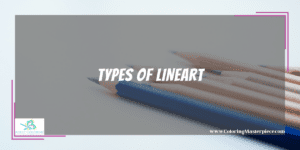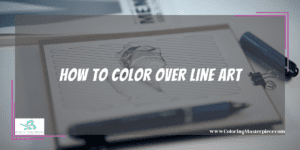Line art is another fun technique to characterize your work of art! Lineart is described as distinct, straight, or curved lines placed on a plain background. It doesn’t always have to be plain, but it usually is! The grading in shading, or hue, to represent two-dimensional or three-dimensional creations is absent in line art, which leans towards representing “realism.”
Types of Lineart

There are many types of ways to draw lines, and many can lead to amazing creations, but others might appear more basic. Some types of lines to use towards your creation can be:
- Thick
- Thin
- Horizontal
- Vertical
- Zigzag
- Diagonal
- Curly
- Curved
- Spiral
Any of these line art techniques can be created with light or dark shading and use different colors, but traditional use tends to stick to monochromatic lines. Line art can be created with any sort of utensil, whether that be a pencil, ink, or through pixels. Line art represents illustrations that consist of varying weight and thickness, according to Adobe.
Line art can be described as the “modern equivalent of playing a song with one instrument” because you are doing all the work with this one utensil and a set of varying lines. It might sound boring without adding color to it, but you can come up with some amazing masterpieces with just simple lines.
Line Drawing is Not Just for doodles
Line drawing may seem like something pretty easy to accomplish, but there’s much more to it, especially when you start to experience coloring the line art. From renowned comic artist Jonathan Case, it is OK to take your time differentiating what you want your line drawing to look like based on the lines and shadowing. Anybody can start doodling and still achieve some wonderful works of art if they keep practicing and experimenting with techniques.
“You have to evoke the transition from dark to light with crosshatching or line weight. heavier lines indicating that the light source is hitting that side of the object” said Jonathan Case. “You have to know how to describe an object in detail to describe it with very little detail; it can help your communication efficiently.” Drawing line art is commonly used for drawing still lives, portraits, book illustrations, comic books, and graphic novels. Next, let’s look at some key tips to follow when drawing line art.
Line Art Tips and Tricks
Now that you learned a little bit of background information about where you might see line art displayed let us look deeper into some necessary tips to follow when drawing line art and eventually creating beautiful art.
- Use contour lines by themselves to outline different parts of your design.
- Add shading with crosshatching.
- Work with varying the weight of the lines.
- Approach your designs with a “warm-up session.”
- Rotate your paper or whatever platform you use as you go, creating drawing strokes away from your body rather than towards your body.
- Keep your line drawing clear and concise. You want it crisp and unpixelated when you are completing your line drawing digitally.
Now that you know a bit of tip to follow when completing the starting part of your line drawing pieces let’s move into the main focus of today: how to color over-the-line art and have a detailed and polished result.
What should we do before adding color to the line art? First, don’t stress over what you are going to do! Your line drawing should be well-defined and easy to read. Before you move forward, always practice with some sketches. This is where you can practice drawing those crisp lines. According to Adobe, it’s best to commit to the first line you draw rather than redoing it over and over again. Trust me; it will drive you a little mad!
With traditional art, that is with pen and paper, some like to color in the background or create whatever background you want first before adding the line art, but others like to draw the line art and then color it in. It is your choice!
Keep an extra sketchbook so you can practice. Keeping a sketchbook on hand is a wonderful way to achieve steady lines because of the warm-ups completed. Try drawing random things around your house. Remember, go with your first line! The more confident you are, the better your illustrations will turn up. Warm-ups are a big key to that mindset.
How to Color Over Line Art

OK! Now, to the fun part. Let’s add some color to your pieces! Coloring your line art by hand on paper can be a bit trickier than digital art, but it is doable! We are no experts, but it is important to stay confident and go slow. Do not rush! Or else it will come out messy.
For digital creators, let’s look into some detailed ways to work your way through colored line art. Using the software Krita, we will get started on how to color in your line art with “flat colors.” To make sure to fill the line art completely and comfortably, it is best to use the “layer stack” option.
This option allows the software to create layers for you! If you tell it to create one object and then create another, the software will automatically overlap the objects. If you switch the commands around, the added object disappears since it was drawn behind it. This process is called the “drawing order,” according to Krita’s website.
Through Krita, the line art is typically black over a white background. To blend the color over the line art, set the blending mode as “Multiply,” or you can use the “Selection” option, which converts the duplicate layer to a “Selection Mask,” and it’s inverted from there. Next, make an entirely new layer, edit, and fill with “Foreground Color,” so you can now add color because the line art is on a separate layer and creates actual transparency.
Digital Line Art
Now that we have gone into the technicalities revolving around hand-drawn and digital art let’s dive deeper into digital line art and where you can get started if you aren’t very familiar with other art software.
Getting started with digital art is fun! You can create whatever you want and have the added ability of the software to complete awesome features without the worry of throwing out countless papers of your failed creations.
First, you should always trace over your sketches or photos you want to use. Work with the layers by adding line art over a sketch or a photo! A great resource for this is finding cool sketches or photos on Pinterest! Always remember to credit the artists for their original outlines that you are using if you decide to go this route.
With Adobe, you can simply grab a picture online, paste it into the software, reduce the opacity, start another layer, and sketch over it, according to Adobe. If you feel like your line art is shaky when doing this type of art, you can easily use the Smoothing tool to autocorrect shaky lines and result in precise lines.
Fundamental Part of Art
To conclude our time experimenting with coloring line art, let’s dive back into the basics. One of the most fundamental elements of art is the aspect of a line and how to draw different types of lines. You can create anything from the start of a simple line drawing. As someone who is not a renowned artist and never plans to be, line art can give way to beautiful inspirations with just a simple start of a line.
Remember to always go with your first line, as mentioned before, or else you will tirelessly spend time perfecting that one line that you should have gone with in the first place. I know artists can be perfectionists, but resist the urge! Go with the flow. The beauty of digital art allows that more easily.
“If you don’t rotate your canvas, your hand is going to get in the way of what your mind wants to put on the paper.” -Jonathan Case, Comic Artist.
Maximize the benefits of coloring with my free adult coloring eBook and sign up for my email newsletter HERE!
Disclaimer: The information provided by ColoringMasterpiece.com (“The Site”) is for general informational purposes only. All information on the Site is provided in good faith, however, we make no representation or warranty of any kind, express or implied, regarding the accuracy, adequacy, validity, reliability, availability, or completeness of any information on the Site. Under no circumstance shall we have any liability to you for any loss or damage of any kind incurred as a result of the use of the Site or Reliance on any information provided on the Site. Your use of the Site and your reliance on any information on the Site is solely at your own risk. This blog post is for educational purposes only and does not constitute legal advice. Please consult a legal expert to address your specific needs.
Terms and Conditions: https://coloringmasterpiece.com/terms-and-conditions/

